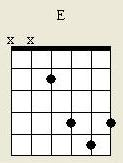This article will only really serve as a brief introduction to the CAGED system of playing guitar. I'm only publishing it to demystify it a little for those who are unfamiliar with the concept. It's really very simple as a concept, and works on a premise of remembering 5 basic open chord shapes, and transposing them up the fretboard toward the bridge by barring off where the guitars nut would be, or by simply playing part of the shape.
The CAGED system is also very useful when it comes to melodic playing and soloing. By using the CAGED system, and by consistently applying it, you will find it easier and easier to fluently choose the notes you want to hear, and you'll find that your arpeggiation of melodies will become off the hook.
The concept, as I said, is simple. Consider these open chords.
C
A
G
E
D
All of those chords have specific shapes. The nut of the guitar (which, in my diagrams, is the dark line at the top) is the 'capo' in the open position. that 'capo' can be moved up the neck. You do this by barring off where the capo is with your index finger. Let's see if I can find a picture...
Ah!
In the image above, this fella's finger acts as the capo.
Now, consider these chord diagrams.
What I've done there is I've taken those five basic open chords and moved each one in turn up a step, barring the notes that need to be parred and omitting the strings that need omitting.
Take the C shape (I'm circling the root note in red),
Take that shape and move it up two frets. Use your little finger (your fourth finger that is) to fret the 5th fret of the 5th string, and lay the other fingers down as the following diagram shows
and viola! A D chord played using the C shape. This is the basis of how the CAGED system of playing works.
Your A open chord (root circled)
moved up two frets (a full step) omitting the 6th string and barring the chord from the 5th string
There you've a B flayed in the A shape.
Next:
moved up a full step to A:
Your open E major chord
up a full step to F sharp
and my last chord pictures for today, open D major
up a full step to E major.
Take those examples and play around with them. Pay attention to the patterns formed by the root notes in each pattern. That's a great way to know which pattern to play when and where more instinctively. Strum the chords. Arpeggiate them (play them note for note in sequence.) Skip notes. When you're done with all of that, refer back to the article on chord formulae entitled "Slugs and snails...". Then you can figure out how to alter these shapes to include minor chords, sevenths and other altered chords.
Above all, enjoy yourself.
If you enjoyed reading this and found it helpful, please feel free to subscribe to my blog or like my facebook page. I write about music, music theory for guitarists, Luthiery and occasionally post articles of a more general nature.
Also, recently I was given an old camcorder by my brother Andrew, and so soon I will be posting a vlog about guitar playing and some of my favorite places in South Africa, which I hope you'll find entertaining and informative.
I play in a band called The Gent's of Leisure. Visit out facebook page:
www.facebook.com/thegentsofleisure
for some music and news of our when and wheres.
Wyrd.























No comments:
Post a Comment